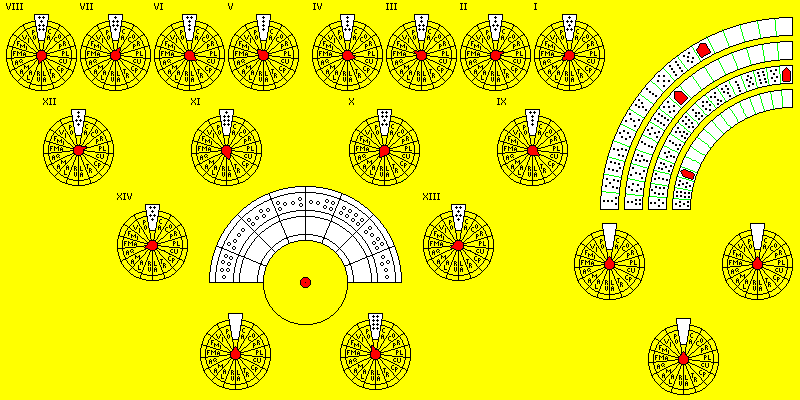
In English, the word geomancy refers to two different practices.
One of them is the Chinese practice of Feng Shui, (literally wind-water) which concerns such matters as the proper placement and orientation of buildings and their doorways.
This page concerns the other practice known by the name of geomancy in English. It is a form of fortune-telling which was popular in the Middle Ages, and was borrowed directly from the Arab world, where it was called Ilm al-Raml.
The volume of the LIFE Science Library concerning Mathematics is one convenient place to find a photograph of the device from the British Museum of which the drawing below is a schematic representation:

This device, made from brass inlaid with gold and silver, was used to keep a tally of the elements of a geomantic chart.
The four large 90 degree arcs conspicuous on the right-hand side of the device were used to make it more convenient to randomly select the starting information for constructing a geomantic chart.
Ordinarily, when constructing a geomantic chart, one draws sixteen rows of dots at random, in four groups of four. A row with an odd number of dots is represented by
*
and a row with an even number of dots is represented by
* *
A geomantic figure represents four rows of dots, from the top down. Thus, there are sixteen possible geomantic figures.
With this device, the four arcs contain curved sliders bearing all sixteen geomantic figures, and thus sliding them to random positions on this device is used to obtain the starting combination.
The four figures thus obtained are entered on the dials marked I, II, III, and IV, representing the first four houses of the geomantic chart. Like the houses of a horoscope, they cover different topics, to which the geomantic figure located in the house is applied.
The dials are so designed that turning the pointer on a knob to the name of a geomantic figure places its picture in the window above the dial. When the dial is pointed at the open window, it is in a neutral position, and the window is blank.
In India, a simpler method of choosing geomantic figures at random is commonly used. A set of four special four-sided dice is joined together by a rod as illustrated below:
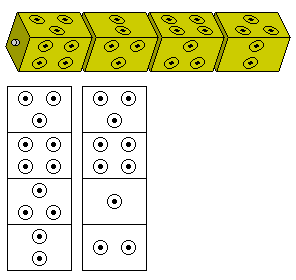
The order of symbols on each die is not fixed, but below the perspective drawing, the two basic arrangements (the first of which is more common) are shown.
One way to use these dice is to take an odd number as representing a single dot, and an even number as representing two dots, and thus one can generate a geomantic figure in one roll.
Another option, applicable only to the first arrangement of the dice, as shown on the left, is to take the symbol on each die as representing two rows of a geomantic figure. In that case, only two rolls are required to generate all four of the figures required to draw a complete geomantic chart; for example, one roll to produce the tops of all four figures, and then another roll to produce the bottoms of all the geomantic figures.
Note that there is no obvious indication of which end of the set of Ramala dice is occupied by the first die; it may be read simply however it appears to the caster, or it may be thrown so that while the dice spin randomly, the orientation of the set as a whole is not likely to change.
Note, however, that the account of how these dice are used by Stewart Culin, on page 65 of the Proceedings of the Numismatic and Antiquarian Society of Philadelphia for 1890 and 1891, published in 1892, involves instead looking up their total in a book of divination. However, an Indian book entitled Ramala Nauratna does indeed describe geomancy, as might be expected by the similarity between the names Ramala and Ilm al-Raml.
The sixteen figures, and the Latin names by which they are known in Europe (in most cases, close translations of the Arabic names), are:
* * * * * * * * * * * * *
* * * * * * * * * * * *
* * * * * * * * * * * *
* * * * * * * * * * * * *
Populus Via Fortuna Fortuna Acquisitio Amissio Albus Rubeus
Minor Major
Cancer Cancer Leo Leo Pisces Libra Gemini Scorpio
Moon Moon Sun Sun Jupiter Venus Mercury Mars
Aquarius Virgo Taurus Taurus Aries Sagittarius Leo Cancer
* * * * * * * * * * *
* * * * * * * * * * * *
* * * * * * * * * * * *
* * * * * * * * * * *
Laetitia Tristitia Caput Cauda Puella Puer Conjunctio Carcer
Draconis Draconis
Sagittarius Capricorn Capricorn Scorpio Taurus Aries Virgo Aquarius
Jupiter Saturn Ascending Descending Venus Mars Mercury Saturn
Node Node
Gemini Sagittarius Libra Capricorn Cancer Scorpio Libra Pisces
Also given are the signs and planets associated with them, as recommended by Cornelius Agrippa, and below that an alternate assignment of signs which he noted as traditional but deprecated.
Agrippa noted that Fortuna Major stood for the Sun by day, and Fortuna Major for the Sun by night, and that Via stood for the Moon from new moon to full moon, while Populus stood for the Moon from full moon to new moon.
As he noted that Puer stood for the positive aspects of Mars, and Rubeus for its negative aspects, I have assigned Puer to the sign Aries; in at least one original edition of his work on Geomancy, it was also assigned to Scorpio, which I take to be an error.
Then four figures are built up to be entered on the dials marked V, VI, VII, and VIII. The rows of the figure entered on dial V are the top rows of the figures on I, II, III, and IV, in order; the rows of the figure entered on dial VI are the second rows of the figures on I, II, III, and IV, in order, and so on. Thus, the figures in the next four houses are produced by a kind of matrix transpose of the figures in the first four houses.
Moving down the tree, the symbols on the remaining dials are found for each dial by performing an exclusive-OR operation on the symbols of the two dials above that dial.
The rule for the exclusive OR operation used here is:
* + * = * * 1 + 1 = 2 odd + odd = even
* + * * = * 1 + 2 = 1 odd + even = odd
* * + * = * 2 + 1 = 1 even + odd = odd
* * + * * = * * 2 + 2 = 2 even + even = even
as shown in three different ways.
Thus, we enter symbols on dials IX, X, XI, and XII as follows:
XOR of symbols on dials I and II -> dial IX XOR of symbols on dials III and IV -> dial X XOR of symbols on dials V and VI -> dial XI XOR of symbols on dials VII and VIII -> dial XII
This continues to obtain the symbols for dials XIII and XIV. The symbols on these two dials are called the "Witnesses", as they are important to the interpretation of the entire geomantic chart.
XOR of symbols on dials IX and X -> dial XIII XOR of symbols on dials XI and XII -> dial XIV
The XOR of the two Witnesses is called the Judge, and represents the chart as a whole. This symbol is entered on the dial on the bottom of the device, to the right of the central dial. Although no number is shown for that dial on this diagram, it can be considered to be dial XV.
Because the two Witnesses are both produced through the XOR of the same group of dots, only symbols with even parity may be produced as the Judge.
The dial to the left of the central dial is used for a symbol which is normally only used if the geomantic chart is, for some reason, ambiguous. If that is the case, this dial (which may be considered to be dial XVI) is used to hold the XOR of the symbols on dials I and XV, which is called the Reconciler.
The additional three dials on the lower right of the device are used to hold two symbols and their XOR for answering specific questions. For a given question, the symbols on two groups of two dials are XORed to produce the symbols to enter on the top two dials, and then they are XORed again to produce the symbol on the dial on the bottom, which is used to find the answer to the question.
The large dial in the center contains a short table of the meanings of the sixteen geomantic figures.
The dials are labelled with the topic area of the house they represent.
I) Querent IX) Travel II) Property X) Honors III) Siblings, cousins XI) Hope and expectation IV) Parents, ancestors XII) Enemies V) Children, descendants XIII) Question VI) Illness XIV) Outcome VII) Love XV) Result VIII) Death XVI) Result of the Result
For the first twelve, these are similar to the meanings of the twelve houses of the horoscope. The eleventh house traditionally deals with friends, particularly powerful ones that can help you, while the character of one's friends is a concern of the seventh house. Here, the label given on this device is quoted, as it, unlike the others, seems to vary somewhat from the general tradition.
In Western geomancy, I to IV are known as the Mothers, V to VIII as the Daughters, IX to XII as the Nieces. As noted, XIII and XIV are the Witnesses, and XV is the Judge, and XVI the Reconciler. Here, XIII refers to the immediate aspect of the situation for which the chart was cast, XIV to the longer-term consequences, and XV to the overall circumstance.
On the island of Madagascar, home of the Malagasy Republic, an interesting variation of geomancy is practiced, in which the geomantic chart is called the sikidy.
In the diagram below, the same geomantic chart as shown on the device above is entered:
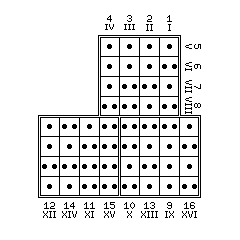
In this version, the Reconciler is always calculated, and is an intrinsic part of the chart.
In addition to the sixteen symbols found in the regular geomantic chart, however, an additional eighteen symbols are read from the sikidy by performing further matrix transposes, and by reading diagonals and broken diagonals, as shown below:
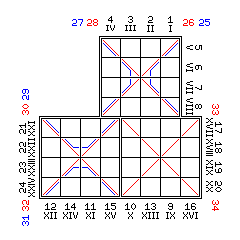
The numbers identifying each symbol are oriented so as to show the direction in which it is read. In the sikidy, the functions of the locations for the symbols are as follows:
1) Querent 9) Path 21) Fault of the living 29) Disaster 2) Property 10) Ancestors 22) Beast of burden 30) Fault of the dead 3) Relatives 11) Food 23) Bad Omen 31) Wild cat 4) Village 12) Spirits 24) Dragon's Tail 32) Unexpected fate 5, 17) Children 13) Mother 25) Hen 33) Incomplete 6, 18) Servants 14) Diviner 26) Rooster 34) Revival of past evils 7, 19) Woman 15) God 27) Sheep 8, 20) Enemy 16) House 28) Goats
Inspired by geomancy, there was a fortune-telling oracle called "Napoleon's Book of Fate" which allowed one to look up answers to several questions on the basis of forming a single geomantic figure, but one with five, rather than four, rows of dots as its source, so that each question could have 32 answers.
Given that Western geomancy, being a form of fortune-telling based on binary quantities, is reminiscent of the I Ching,
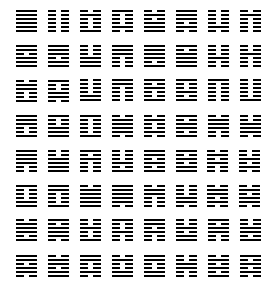
it might be of interest to note that there was yet another fortune-telling oracle of this form, originally written (or "edited", if one believes its origin story) by Raphael, and then later published by Zadkiel, "The Royal Book of Fate", which used geomantic figures that were composed of six elements.
The sequence given for these geomantic figures was:
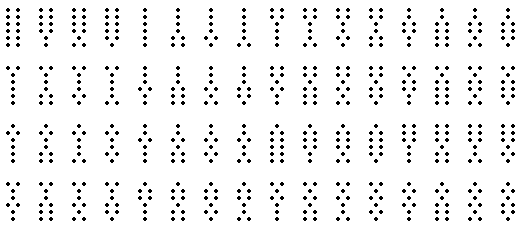
In this sequence, the symmetries are more obvious.
The symbols are in groups of four in which the first four rows of dots are the same. The sequence of the patterns of the first four rows is not the same as the conventional sequence of geomantic symbols, but it is close:
Populus Via Fortuna Major Fortuna Minor Caput Draconis Cauda Draconis Albus Rubeus Puella Puer Laetitia Tristitia Conjunctio Carcer Aquisitio Amissio
As all four symbols with a given value of the first four rows are grouped together, all the four possible arrangements for the last two rows occur in each of those groups. Their ordering varies quite a bit initially, and then settles down somewhat later on in the sequence.
Copyright (c) 2002, 2012 John J. G. Savard